In June 2020, Gov. Mike Dunleavy signed an Administrative Order that would establish a working group to conduct an analysis and make recommendations related to 911 and Alaska State Troopers dispatch consolidation. The idea was to consider opinions of first responders, community leaders, the telecommunications industry, stakeholders and Alaskans across the state before final decisions were made, however a majority spoke against the consolidation plan last fall.
DPS Commissioner Jim Cockrell explained the consolidation plan to KSRM’s Sound Off:
“So essentially, the Department was moving towards consolidating all our assets into one dispatch center, which originally was going to be in Anchorage and then it got moved to Palmer. Bottom line is, there was some big gaps in our consolidation plan. We’ve put that on hold, and we’ve signed contracts with both the Kenai Peninsula Borough and the Matanuska Borough for dispatch services. We still have Fairbanks, again, Fairbanks handles Western Alaska. One of the reasons for the big consolidation plan was to provide better 911 services in rural Alaska. Again, I’m talking rural, rural Alaska; be Aniak, Emmonak, those types of places. Currently, if we receive a 911 call from, we’ll say Emmonak, that call would get routed to the Fairbanks dispatch center as an 800 number. It doesn’t actually give us the community that the number came from, nor does it give us a telephone number that the person called. We don’t have that ability in most of rural Alaska. That was one of the areas.
Cockrell explained the issues locally that would happen if this consolidation plan took place:
“If we had our consolidated dispatch center in Palmer or Anchorage, if we received a 911 call here regardless if it was meant for the Alaska State Troopers, it would still go to the Kenai Peninsula Borough, they would have to forward that call to our dispatch center in either Palmer or Anchorage and then have to dispatch a car from Anchorage to go to a call on the Kenai Peninsula Borough.”
He also said that in the event of a response that required both Alaska State Troopers and local EMS and police, the efficiency on how the call is handled could be lost.

